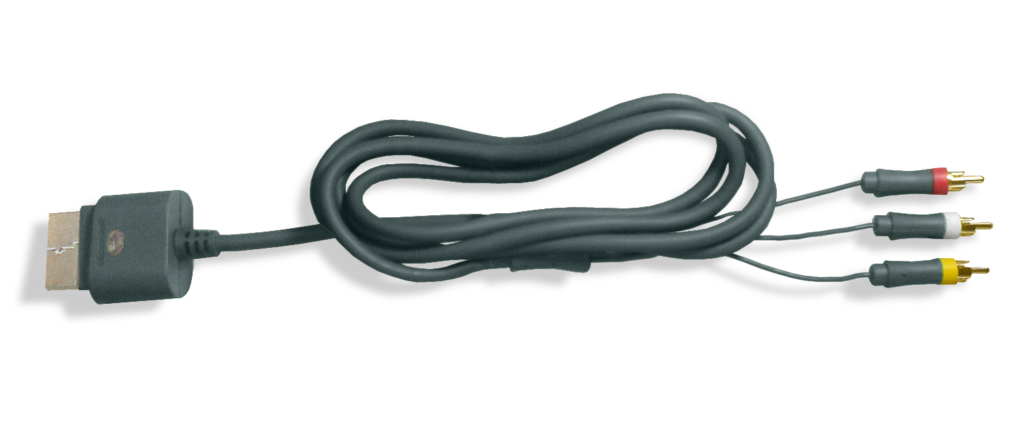Composite video is a single-channel analog video transmission format that carries standard-definition video at 480i or 576i resolution. Unlike the higher-quality S-Video (two channels) and even higher-quality component video (three or more channels), video information is encoded on a single channel. Audio is supplied on a separate connection in all of these video formats.

The yellow cable represents the composite video. Composite video is also called SD video for the standard-definition television signal it transmits or by the letters CVBS for composite video baseband signal or color, video, blanking, and sync.
The composite video comprises three types: NTSC, PAL, and SECAM.
What is Composite Video?
History of Composite Video
When color was introduced to black-and-white television in 1954, the composite video was born. The original monochrome signal (Y) was multiplexed with two color channels (U and V) and broadcast on the same TV channel.
Composite Video vs. Component Video
Composite Video
A composite video cable, often known as an RCA or “yellow plug” cable, is an outdated standard for transmitting video signals via a single cable and connector. HD content and progressive scan images are not supported. As the video signal must go over a single wire, it is significantly compressed, resulting in a loss of resolution and clarity. Radiofrequency interference wreaks havoc on the cables, lowering picture quality even more.
Component Video
Component video divides video transmissions into three cables: green, blue, and red, each of which transmits a different part of the video signal. The signal’s brightness information is transmitted via the green cable. The blue and red connections transfer the picture’s blue and red components.

Relevance of Composite Video
Composite video is a disappearing technology that cannot handle high-definition video streams. Choose component over composite whenever possible because this connection will consistently deliver a better picture at greater resolutions. Composite video is only helpful nowadays if you use outdated technology like video game consoles or VCRs that don’t support the component video format. As a result, several modern HDTVs come with at least one composite video input to allow them to work with older equipment.
Relevance of Component Video
Component cables initially supplanted composite as the de facto analog video cable due to their superior picture quality and HD compatibility. At least one set of component inputs is found on nearly all modern HDTVs. In addition, most video game consoles, DVD players, digital video recorders, cable set-top boxes, and Blu-ray players support component video.
Composite Video vs. Component Video
Composite Video vs. S-Video
Composite Video
As mentioned above, Composite video adapts the format of an analog picture signal, which is coupled with sound signals and modulated by an RF Carrier. It’s a composite signal made up of sync pulses and three separate sources named Y, U, and V. Luminance is represented by Y. In contrast, hue and saturation are represented by U and V, which together make up chrominance. As a result, the information on the color signals is carried by U and V simultaneously.
S-Video
S-video is also known as “separate video” and is sometimes referred to as “super video.” This video analog transmission conveys information in two separate signals: chroma and luma, which stand for color and brightness, respectively. It only carries standard-definition video and does not combine it with audio signals in a single wire. S-video and Composite Video differ from one another in several ways.

Relevance of Composite Video and S Video
The composite video was first utilized in larger television sets and older VCR models. Due to its superior picture quality, S-Video has steadily replaced this as a popular alternative for televisions, high-end VCD players, video game consoles, and graphics cards. Even though composite video provides strong signals, S-video is more common due to its improved visual quality.
Composite Video vs. S Video: Quality Comparison
Converting Composite Video to HDMI
There are many different connectors for audio-visual equipment, but they all fall into one of two camps: digital or analog. Older gadgets use analog transmissions, whereas newer devices use digital signals, and they all require different connectors to work together. For example, analog signals in a home theater typically employ either connector types: composite or component. The video connector on a composite RCA cable is yellow, whereas the audio connectors are red and white.
HDMI (High Definition Multimedia Interface) ports, which employ digital signals, are found on most HDTVs. Compared to analog communications, digital signals provide more extraordinary sound, higher resolutions, and better color.

However, just because you want a better movie experience does not mean you have to acquire all new equipment. You may convert the signal from your older source to operate with your HDMI TV by using affordable composite to HDMI or component to HDMI converters. Many adapters can convert composite video to HDMI and upscale the picture to 720p or even full 1080p HD.
Converting Composite Video to HDMI
Connectors and Cable for Composite Video
The composite video signal is connected via a yellow RCA connector in most home applications. It frequently comes with red and white audio connectors for the right and left channels. Professional television studios and post-production applications often use BNC connections and higher-quality coaxial cable. BNC connectors were also utilized for composite video connections on early home VCRs, frequently with an RCA or a 5-pin DIN connector for audio. The BNC connector predated the PL-259 connector used on early VCRs.

Composite Video – Artifacts
A dot crawl is a checkerboard visual artifact caused by merging component signals to generate the composite signal. Dot crawl is a signal defect caused by signal crosstalk caused by the intermodulation of the chrominance and luminance components. This is most noticeable when chrominance is broadcast with wide bandwidth, and its spectrum extends into the luminance frequency region. Comb filters are widely employed to separate signals from composite sources and remove these abnormalities. S-Video and component video circumvent this issue since the component signals are kept separate.
Conclusion
Composite video might be fading into irrelevance with the advent of more advanced video transmission formats. However, to its credit, the composite video format managed to survive the onslaughts of component video, S video, and HDMI. TV manufacturers still reserve a slot to insert composite video cables. Composite video might have turned into a niche, but it seems like it will take a while before it goes extinct.













